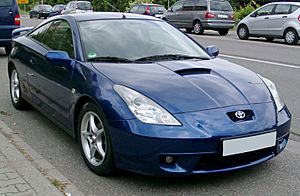Toyota Celica facts for kids
The Toyota Celica was a cool sports car made by the Japanese company Toyota. It was known for its sporty look and fun driving experience. Toyota started making the Celica way back in 1970. They stopped selling it in 2005 because sales were a bit low. Another car, the Scion tC, took its place. Over its many years, the Celica changed a lot, with different designs and engines, but it always kept its sporty spirit.
Contents
What Made the Celica Special?
The Toyota Celica was popular for many reasons. It was a stylish car that looked fast even when standing still. It also offered good performance for its price, making it a favorite for people who wanted a sporty car without spending too much.
Celica's Rally Racing History
The Celica wasn't just a car for the road; it was also a champion in rallying. Rally racing is a tough sport where cars race on different surfaces like dirt, gravel, and snow. Toyota used special versions of the Celica, called the GT-Four, to compete in the World Rally Championship (WRC). These cars were incredibly powerful and helped Toyota win many races and championships. This racing success made the Celica even more famous and showed how tough and capable it was.
Different Generations of the Celica
Over its 35-year history, the Toyota Celica went through seven main design changes, known as "generations." Each generation brought new looks, improved technology, and different engines.
First Generation (1970–1977)
The very first Celica came out in 1970. It was inspired by American muscle cars but was smaller and more fuel-efficient. It quickly became popular because it looked great and was fun to drive. You could get it as a coupe (a two-door car) or a liftback (a sporty car with a sloped back and a large rear hatch).
Later Generations (1978–2005)
As the years went by, the Celica continued to evolve.
- The second generation (1978–1981) had a slightly more angular design.
- The third generation (1981–1985) introduced pop-up headlights, which were very popular at the time. This generation also saw the Celica become a rally superstar.
- The fourth generation (1985–1989) was a big change. It became a front-wheel drive car, meaning the engine powered the front wheels. This made it more stable and easier to drive for many people. This is also when the famous GT-Four model, with all-wheel drive and a turbocharger, became a rally legend.
- The fifth generation (1989–1993) had a smoother, more rounded shape. The GT-Four continued its rally success.
- The sixth generation (1993–1999) kept the rounded look and brought back the four round headlights. It was still a strong performer.
- The seventh and final generation (1999–2005) had a sharp, futuristic design. It was lighter and more agile than previous models, focusing on a fun driving experience.
Why Did Production Stop?
Even though the Celica was a beloved car, its sales started to slow down in the early 2000s. People were buying more SUVs and different types of cars. Because of this, Toyota decided to stop making the Celica in 2005. It was a sad day for many car fans, but the Celica left behind a great legacy as a sporty and exciting car.
Images for kids
See also
 In Spanish: Toyota Celica para niños
In Spanish: Toyota Celica para niños































